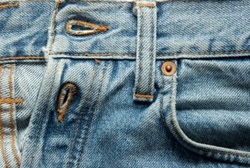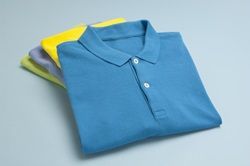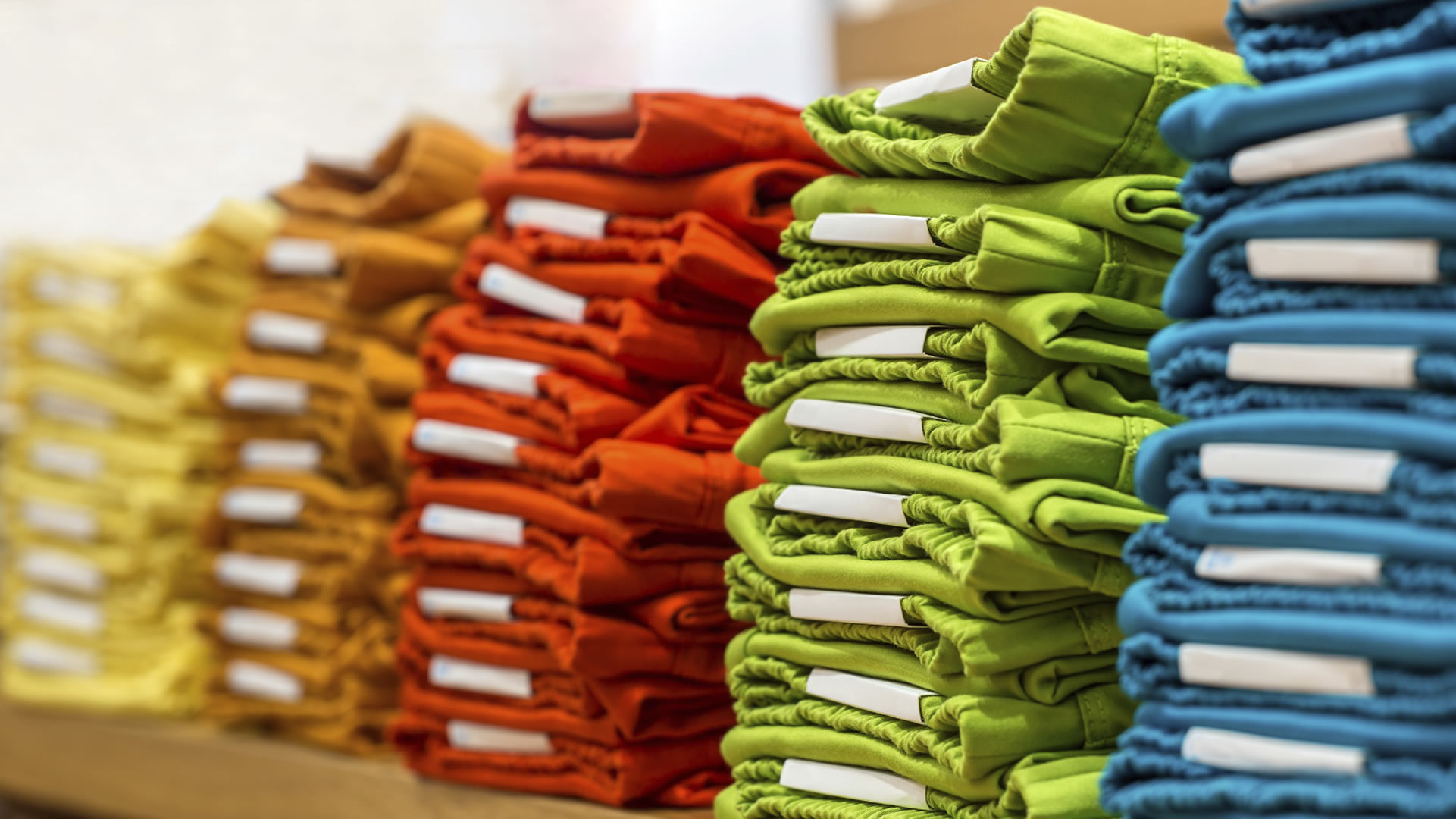
Sewing Post Dyed Garments
Contents
Introduction
Why Garment Dyeing?
What are the negatives of Post-dyeing Garments?
Choosing Sewing Threads
Coats Thread Recommendations
Machine Setting Recommendations
Recommendations for Non Sewing Issues related to Garment Dyeing
Introduction
In the world of fast fashion when time to market is paramount, garment dyeing post make up is increasingly adopted by manufacturers.
Apparel dyeing has implications for the finished quality of the garments and this bulletin explains how to minimize the negative impact of this process on general seam appearance and sewing related issues. We explain the dos and don'ts of sewing post dyed garments.
Why Garment Dyeing?
Generally, apparel is constructed from fabrics that are pre-dyed (piece dyed) before the actual cutting and sewing. The color and quantity are committed to at the fabric dyeing stage with resultant long lead times to market and less forecast accuracy.
For seasonal fashion colors it is possible to react much closer to actual market demand if the apparel is post dyed. This involves the production of garments from undyed fabric and components and subsequently dyeing them in the required quantities.
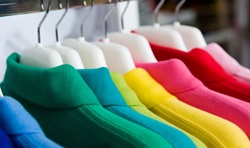
Post dyeing has many advantages:
- Simple one shade production
- Stock reduction - finished goods and trimmings
- Allowance for specialized finishes, which are applicable to the whole garment. i.e., tie dye, spray dye, dip dye and pigment dye
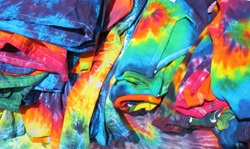
What are the negatives of Post-dyeing Garments?
Not suited to all fabrics
- On densely woven lightweight fabrics there is a high risk of seam pucker if cotton sewing threads are used of relatively high grist to achieve adequate seam strength. 100% cotton fabrics are low in elongation and therefore the fabric yarns are displaced around the needle and thread increasing the degree of seam pucker
- On lightweight fabrics that require fine ticket sizes of thread, seam strength can be compromised
- Fabrics with high stretch properties, such as those containing Lycra can give problems with seam extension due to the low elongation properties of 100% cotton sewing threads
Not always providing the desired final appearance
- Garments that follow the post dye route have a "casual / washed down" appearance. Where a pristine finished look is required the post dye route is not recommended
- When manufacturing intimate apparel, the desired softness of the seam that is provided by textured sewing threads (i.e. Coats Seamsoft) is not achievable with 100% cotton sewing threads
Potentially high damage and repairs rate
- Post dyeing is a relatively harsh process that can result in damage to the garments
- When making garments in the "greige" state needle and / or feed dog damage is not always evident. The garment dye process can expose these small levels of damage resulting in a high level of seconds
High risk of inappropriate sewing thread use
- It is imperative when embarking on a garment dye program that ALL of the previously used sewing threads are cleared from the sewing machines and the thread storage areas, and that ALL sewing threads are segregated and clearly marked
- Past experience has shown that on numerous occasions, failure to remove the residual thread from ALL lockstitch, stitch type bobbins on the sewing line (including the bobbins in the machine drawers etc.), has resulted in large quantities of garments being produced which are not saleable or repairable due to even the slightest contamination of the seams
No guarantees of absolute compatibility even in apparently ideal situations – fabric shrinkage
- Fabric shrinkage is often higher than the minimal amount of shrinkage in the sewing threads. This can result in a high degree of seam pucker. This seam pucker is often perceived as excessive thread shrinkage
Fabric swelling
- The fabric shrinkage levels (x and y) may well be low in percentage terms but in the third (z) dimension, the fabrics construction yarns may volumize significantly resulting in there being insufficient sewing thread in the seam causing poor seam extensibility and seam pucker in the woven fabric
Choosing Sewing Threads
For the best results in terms of color uptake, the sewing thread to be used on post dyed garments should be in the same fiber as the fabric.
Cotton Threads
Cotton is the most common fiber used and ideally the thread should be prepared similarly to the fabric. For example, if no optical brightening agent (OBA) is used for the fabric it should not be used in the sewing thread. Similarly a mercerized cotton thread with increased dye affinity should not be used in an unmercerized fabric.
100% Cotton threads are coarser than synthetic threads for the same strength and are relatively low in elongation. Low elongation threads require:
- Light sewing tensions / high stitch densities to achieve the required seam strength and elongation and avoid puckering after dyeing
- The thread ticket size must suit needle size and the sewing application. A heavier thread size may require attention to thread trimmers to ensure clean cutting
Synthetic Threads
With synthetic fibers, even when using apparently identical material for fabric and thread, absolute compatibility of shade cannot be guaranteed. For example, difference in thermal history of polyester yarns used for thread and fabric may cause differential uptake of dyestuff. In the case of nylon, the properties of nylon 6 are different from those of nylon 6.6. It is the latter version which is usually used for sewing thread.
PFD synthetic fabrics are usually scoured and without OBA. For this reason a natural synthetic thread should be used.
The thickness of the synthetic thread used for synthetic garments dye products will be identical to that used for conventional production. Again, minimal thread shrinkage is required and light tensions in sewing will be helpful to seam appearance after dyeing.
Coats Thread Recommendations
Coats Dymax - 100% Cotton
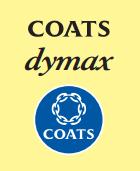
Coats Dymax is a fit-for-purpose mercerized cotton sewing thread specifically for garment dye end-use.
For both untreated and mercerised 100% cotton fabrics Coats Dymax mercerized cotton thread is produced from high quality, long staple cotton specially treated under tension to provide greater lustre and higher strength.
Coats Dual Duty Supercotton - Corespun
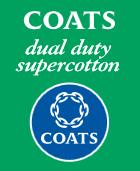
- Coats Dual Duty Supercotton is a top quality corespun sewing thread for use in the manufacture of post dyed cotton garments.
- The high tenacity polyester core provides higher tenacity and elongation as well as lower shrinkage compared to 100% cotton threads leading to superior seam quality
- Special cotton wrap provides excellent dye uptake
- The cotton wrap is natural to take up the color of the finished garment and the thread core is pre-dyed in a range of colors to match light, medium and dark shades*
- Unique corespun construction delivers enhanced sewing performance and abrasion resistance even compared to "premium" quality 100% cotton threads
- Use of finer needles than possible with 100% cotton threads to get same seam strength
*Some markets offer a wide range of core dyed shades.
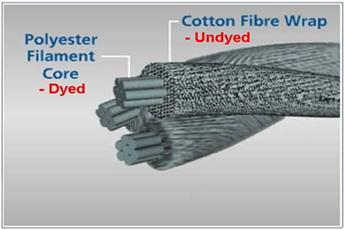
Machine Setting Recommendations
- Speeds may need to be lower for natural products than those used for synthetic threads. This is particularly true for lockstitch machines due to the demanding nature of the thread handling systems
- Machine condition can negatively affect the sewing thread performance. 100% cotton sewing threads will be more susceptible to damage during sewing
- Larger needles to accommodate coarser thread can increase the risk of fabric damage. Particular attention should be given to this point given the harshness of the subsequent dyeing process
- Hook, looper and feed timings may need to be adjusted to accommodate the use of 100% cotton sewing threads
- On machines with oscillating shuttle hooks the timing of the hook may need to be advanced
- On lockstitch buttonhole machines a "whip stitch" set up is preferable to a "purl stitch" set up, as this facilitates the use of lighter needle thread tension
Recommendations for Non Sewing Issues related to Garment Dyeing
- A pre dye and post dye garments size chart is used for checking the critical dimensions of the garments before and after wet processing
- A segregated area for the assembling of dyelots of garments in size ratio
- Segregated area for goods being returned from dyeing to be processed as follows:
1. Sorting
2. Inspection
3. Measuring
4. Post dye sewing such as label attaching, button sewing and buttonholing
5. Finishing including pressing (this may need to be undertaken with the garments in a damp state)
- Most labels and packaging materials will be color specific and therefore should be made available in the correct ratio to suit the returned batch of garments
- Prior to any production run, dye trials should be carried out using the correct fabric, across ALL shades. These trials should include strip and redye or overdye, as these processes may need to be employed should a dye-lot fail or if any dyed garments need to be re-processed.
Please contact your local Sales Office to find out more about sewing post dyed garments.

